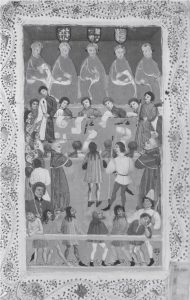Poem 1 “Miracle of the Boy Singer”
Bodleian Library MS English Poetry a.1, fol. 124v (Vernon) The Vernon manuscript is the longest and largest surviving volume of Middle English writings; it was originally over 420 vellum leaves long, the pages ruled in 2 or 3 columns with over 80 lines of text each. The contents include passages from the South English Legendary, Northern Homilies, miracles of our Lady, poems, and prose pieces generally of vernacular theology. Of the original 41 Virgin miracles in the manuscript (compilations of which were popular among men and women in the later Middle Ages), 9 survive. The second poem’s narrative is “Hou the Jewes in despit of ore Lady threwe a chyld in a gonge,” one of three extant poems containing Jewish characters. Anti-semitic stories were common in the later Middle Ages, particularly in Marian legends, and stories of the murder of Christian children by Jews in England first appeared in Norwich after 1144 and in Lincoln in 1255.Even though the Jews were officially expelled from England in 1290, the stories remained popular.
The five-part story is depicted in compact form in muted greens, browns, and reds, with the bishop’s clothing illuminated with gold: the old Jew invites the boy who has been singing the Alma redemptoris mater into his house, cuts his throat, and then pitches him down the “gonge,” or toilet. On the lower right, the mother pleads before the mayor and bailiff, and on the left the bishop holds the lily found in the boy’s throat which, the poem states, had “Alma redemptoris mater” inscribed on it in gold letters. In the poem also the boy’s corpse rises during his funeral and sings “Salve, sancta parens” (“Hail, holy mother”). The poem’s version of the child’s hymn reads: “Godus Moder, mylde and clene / Hevene gate and sterre of se, / Save thi peple from synne and we [woe].”

Poem 2 Court of King’s Bench
By the fourteenth and fifteenth centuries, England’s secular court system was highly developed and extensively centralized. Three main branches administered justice: the Court of King’s Bench was the highest court of appeals and also the court that dealt with matters relating to the king’s person and property; the Court of Exchequer principally handled financial cases; and the Court of Common Pleas adjudicated the matters of private free individuals. The Chancery was the central royal governmental secretarial office. Centered in London, these courts also administered itinerant justices, who traveled around the country to adjudicate local trials and disputes, advising, working with, and superseding the many local courts around the country (see “The Revolt,” p. 175). The principal forms of justice were writ and jury.
The Inner Temple Library manuscript survives only as four manuscript leaves that show the four courts, each in vivid colors. Presumably they belonged originally to a law treatise. The Court of King’s Bench image shows five presiding judges, below them court officials, two ushers on the table, and a jury to the left. A marshal guards the prisoner, and two sergeants-of-law stand on either side in front of other shackled prisoners.

Primary documents and further reading
Alford, J. A. (1977) “Literature and Law in Medieval England.” PMLA 92: 941–51. Alford, J. A. and D. P. Seniff (1984) Literature and Law in the Middle Ages: A Bibliography of Scholarship. New York: Garland. Baildon, W. P. (ed.) (1896) Select Cases in Chancery, A. D. 1364 to 1471. London: Seldon Society. Fortescue, Sir John (1997) On the Laws and Governance of England, ed. S. Lockwood. Cambridge: Cambridge University Press. Green, R. F. (1999) “Medieval Literature and the Law.” In D. Wallace (ed.) The Cambridge History of Medieval English Literature. Cambridge: Cambridge University Press, 407–31. Plucknett, T. F. T. (ed.) (1929) Year Books of Richard II: 13 Richard II, 1389–1390. London: Ames Foundation. Pollock, F. and F. W. Maitland (1968) [1895] The History of English Law Before the Time of Edward I, 2 vols. London: Cambridge University Press. Sayles, G. O. (ed.) (1971) Select Cases in the Court of King’s Bench under Richard II, Henry IV, and Henry V, vol. 7. London: Seldon Society.Brown, C. (1910) A Study of the Miracle of Our Lady Told by Chaucer’s Prioress. London: Chaucer Society. Doyle, A. I. (Intro.) (1987) The Vernon Manuscript: A Facsimile of Bodleian Library, Oxford, MS. Eng. Poet. a.1. Cambridge: D. S. Brewer. Horstmann, C. and F. J. Furnivall (eds.) (1892, 1901) The Minor Poems of the Vernon Manuscript, 2 vols. EETS, o.s. 98, 117. London: Kegan Paul, Trench, Trübner.
I am so dead tmrw. I don’t know what I’ve been thinking. I forgot to do peka, forgot to hand in my literature and forgot to do GB. Bye.
RT 62: Integrated wired solution a key to Champion status in report
What literature? Lemme knw how well u knw ur literature
Do not pity the dead, Harry. Pity the living; and above all, pity those who believe 50 Shades of Grey is actual literature.
I’m really only having trouble in History, and American Literature. They suck.
86 LOOOL eeeh wallah XD
I find it humorous that “doing DH” for some is simply blogging about literature. Wow. Exciting…
i still cant believe i failed literature hahaha
I just started and I already wanna get this reading and literature part II outta the way. too much writing…
Yay, children’s literature!
Fun!!! Amazing Literature-Inspired Jack-O’-Lanterns
Beliebers are Juliet and Justin is Romeo. Scooter is Shakespeare, because without him the story wouldn’t have been written. ♡
“: What is the cause of thunder?” Thor.